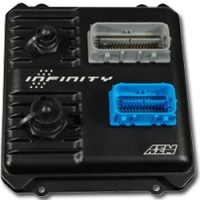Product Description
Put simply, Engine Control Units (ECUs) are designed to electronically control fuel injected internal combustion engines.
In its most basic form an ECU monitors the engine through sensors and uses this information to determine the quantity of fuel to inject and the timing of the ignition depending on engine speed (RPM) and engine load conditions. Typically, an ECU will use throttle position, manifold absolute pressure (MAP) or mass air flow (MAF), or a combination of these to calculate the load conditions.
Programmable ECUs
All calibration and tuning parameters in a factory ECU are fixed by the manufacturer to suit the engine in its standard form and it is often impossible to adjust this for engine modifications.
However, if the factory ECU is replaced by a programmable aftermarket system, adjustments can be made. An engine tuner can connect the ECU to a PC to tune the engine for optimum performance at each load and speed condition. This requires dedicated tuning software and the sophistication of this software is one of the key differentiating factors from one brand to another.
Modern Functionality
These days, aftermarket ECUs not only control injection and ignition timing, but also manage more complex functions like boost control, idle speed control, intercooler spray bars and traction control. Many ECUs provide extra auxiliary outputs that can be used to activate devices such as pumps, fans and even servo motors.
Recent engine development has led to electronic innovations like continuously variable camshaft timing and drive by wire throttle systems. This has created a need for more sensor inputs and auxiliary outputs and a higher processing speed in the ECU.
These advanced installations require several electronic devices on the vehicle to constantly exchange information using very fast communication. Currently, the most efficient method is via a CAN bus (controller area network), consisting of just two wires.
Data Logging
ECUs with on board data logging provide several advantages for the tuning of high performance engines, allowing users to record and then analyze various engine parameters. The detailed information can be used for fine-tuning the engine and targeting small refinements that can deliver significant performance gains. Logging is also an invaluable tool in helping to detect early signs of engine health problems.






Reviews
There are no reviews yet.